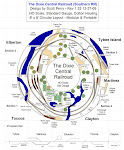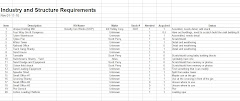Early this morning I snuck down to the train shop and put together another bent and left it to dry.
Later I came back and flipped it over so that I could but the sway braces on.
Using my handy glass top I squeezed Elmer's directly on to the surface.
Carefully I dip both ends of the sway brace into the glue being carful to only get a very small amount onto the board's ends.
Using a very good pair of tweezers (slightly curved points, sharp, precision stainless steel) I lower the brace into place.
...and then I shove the final parts into the assembly jig.
Great! Right after breakfast the last bent is dry.
They are coming out straight and with the mottled color that I wanted.
Here are the magnificent seven! The one on the left is Uyl Brenner.
Referencing my drawings I double check the measurements of the small bent against my jig just to make sure they match. Good! The left hand side of the jig will be used for making the smaller bents.
Back on the chopper I set up the fence for the dimension and start making sawdust. We'll only need four of the caps and eight of the sway braces. All of the pilings are cut and stained.
Here are the small bend top caps. I'll distress them with the saw on all sides.
After cutting the sway braces with the Northwest Shortline Chopper, I stick them to some Scotch Magic Tapic and paint/stain them CAREFULLY. I'm using a dry brush technique here to avoid warping.
Here is the test bent. The boards look off center, but that is just the odd camera angle. It is amazing how strong these guys are.
With the caps and braces stained we start to assemble the four bents. This will go quickly.
In about 7 minutes it is braced on both sides and dry.
I put another one together in the jig and while it is drying I'll work on the Pier Wall. These boards are overhanging and need to be cut off flush. Normally I use my jeweler's saw, but there is not enough room.
The Zona Saw is very sharp and makes quick work of it. You have to watch the Zona Saw because it has a top cap along the blade for support. As you cut something long the cap starts to defect the blade. That is why I like the jeweler's saw better.
Here we have a nice cut along the end of the wall. I'll hit it with the palm sander and flatten it out.
I cut this end with the Zona and got the deflection that I talked about. It leans a bit, so I'll hit it with the sander to level it out.
It is more uneven than the sander can handle, so I'll have to cut some more off. This time I used a rule to keep the blade straight. When you do this use a STEEL rule, not an aluminum one as the saw will cut into the aluminum.
Once sanded it is now flush. I'll come back and touch up the color later.
On the small inside wall, which is hidden by the pier somewhat, I quickly install the boards which were cut on the chop saw. I was careful not to use too much glue. Get used to using less and less Elmer's glue. It is very strong and a little goes a long way, while a lot will ruin the surface of the model.
There! All done. Now, while still building bents, we'll finish the long back wall.
All four small bents are now done. That went quickly!
Since I'm through with the bents I put the jig, the test bents, left over pilings and pieces into a Glad Brand Zipper Bag and labeled it. This way I know what the jig is, what it can make, some pieces to used to set up saws and a couple of samples.
Good Thing: My daughter stops by to steal an animal cracker and give me a kiss.
Bad Thing: energetic daughter doesn't watch where she is walking and knocks the module over with a CRASH. All of the track supports were destroyed and will have to be replaced. The luan is damaged as well, so we'll need to do some repairs. Actually I'm amazed that it took such a shock and didn't explode. I had not screwed the risers in yet, otherwise it would not have broken at all. This shows me that the single leg "kick leg" is not enough for the stand along module.
Hey Bob....what should I do?
Since I'm through benting...I'll clean up the work space and prepare for the final assembly stops.
Here is the back pier wall drying with the use of clamps and Rick's Popsicle Sticks. I still have some glue sneaking out and promise to use even less next time.
Using two print outs (it all won't fit on one page) I pieced the top view drawing on the glass and then covered it with wax paper using some Scotch Tape.
I cut the remaining stained boards (some are only partially stained) and then distressed, painted and stained the untreated sides. Be sure to get the ends!
Using just a very tiny bit of glue here and there I lightly glued the runners in place just to hold them steady. We'll need to lift them off the wax paper later.
Using a steel right angle with a soem weight on the bottom I put glue where the bent and runner intersect and glued them into place giving each bent time to dry before placing the others. If you don't they will fall over like dominoes if you bump them.
It is here that I began thinking about how the bents would look on the front and noticed I HAD BUILD IT BACKWARDS! Shit.
You have to flip the drawing when you build it upside down. Now I'm in a pickle. The bents won't come off.
I took the Zona Saw and cut through the runners. We'll go ahead and assemble it, then move the smaller pier to the other side. Crap. That is not going to look good.
Here is the upside down pier with all the bents installed. I'll come back tonight and make some sway braces for the sides. These board by board structures, while very simple to make (when you aren't making mistakes) are VERY impressive and make people go "Wow! You scratcbuilt that?" A kit for a piere like this would cost you $70. As it sits it probably cost me $24.
Edited 01-20-10 The Blogger was smoking weed, per the Blogger's wife. My cost for this (Miss Slavedriver keeps all the receipts) is more like $60. I forgot that I paid for the deck boards a long time ago, and forgot a side trip to Hobby Lobby. Next time, I'll buy a kit! :)
The bents are nicely colored.
Here you can see the cut.
Almost done! Just need another hour to put the sway braces on the side, and then another two hours or so for planking the top and adding details (which I won't put on yet.)
We'll keep the top flat for now until we mount it in the water. You can get some warpage when you pour water around an object so we want a flat surface for the weights we'll need on top.
Ok, not a disaster, but not a contest winner either. But I'm not after big contest wins, just the 87.5 points I need for a structure in the NMRA AP program.
















































No comments:
Post a Comment